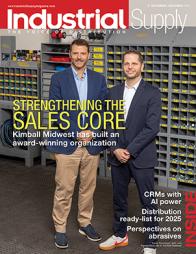Customer returns
How the warehouse can help
By Dick Friedman
Thanks to great efforts on the part of distributors, customers have become accustomed to getting almost all the items they want, in the ordered quantities, at the right prices, when needed. Now, many customers expect to quickly get credit or a refund for their returns, especially when a return is not the result of a customer’s mistake. Here are some recommendations for effectively handling returns, the resolution of which will always takes a back seat to filling orders, and receiving in and putting away purchased items.
Organization
Not too far from the receiving area, set up shelves and/or racks to be used only for storing customer returns (including items for which a customer refused delivery); temporary storage. One or more of these shelving units would be used for storing: un-inspected returns; inspected, salable items; items that must be inspected by a factory or manufacturer’s rep; inspected returns that can be returned to vendors; inspected items that are to be scrapped. Determine the quantity and purpose of each category of shelving from the recent history of returns. Label each bay as to its purpose (inspected items, to be scrapped), and label each shelf (and perhaps each slot) with a unique storage location ID.
Information
Most distributors “require” that nothing be returned without a distributor-issued Returned Merchandise Authorization (RMA) number; sometimes, not without a printed RMA form. But items will be returned without an RMA number or form, so print a blank Returns Information form, and give several to each driver, and keep several in the receiving area.
As returns are received, before the customer or truck driver leaves, those doing the receiving should determine if an RMA form accompanies the return. If not, fill in a Returns Information form, including, if possible, the reason for each return (and use that data to try to prevent returns due to distributor fault). If there is an RMA form, use it to record the reason for the return.
Next, the newly-received items should be placed in the dedicated returns shelving, not on the floor, and each item’s location should be recorded on either the RMA or Returns Information form. Data from each completed form should be entered into the computer system throughout the day but no later than the next day.
Resolution
Time permitting – see first paragraph, last sentence – for items in each stage (storage location), print a list, sequenced by the date of data capture for that stage, so that the earlier receipts can be addressed first. Goal No. 1 should be to use the list to make a decision for every item in the un-inspected storage area(s), and do so within 48 hours of receipt. For each decision, move the item to the appropriate shelf. Effective customer service requires that each return be tracked at each stage so it does not “fall between the cracks” and the result of each decision should be recorded on a Returns Information form; and that data used to update information in the system.
Goal No. 2 is to grant credit (or a refund) for items that are salable, that can be returned to vendors, and that are to be scrapped but were not damaged by the customer returning them. These items can be identified by information in the system, based on the storage location(s). For items that must be inspected by a factory or manufacturer’s rep, be sure to let the customers know that credit cannot be given until that inspection occurs, which could take a few weeks. Inform reps that inspections are needed; keep track of contact with reps, so it doesn’t take too long for an inspection to occur.
When items are returned to stock or to vendors, or scrapped, use an inventory adjustments form to record the new storage location for each item moved or scrapped. Distributors who use bar code scanning do not need any paper form.
After each inspection by a rep, again use a Returns Information form to record the resolution for each item and customer. Then either grant or deny credit, but in either case let the customer know what happened – and if credit is denied, why it was denied. Finally, when the items are moved, use a form (or RF gun) to record each new storage location.
If this seems like a lot of work for no money, it is; it’s a money loser. To reduce mistakes made by distributor personnel, carefully examine warehouse organization, management and operations (receiving, put-away, truck loading). For operations, look at procedures, controls, forms, user skills, and use of related ERP system features. Try to identify root causes of the mistakes and define changes that would prevent most mistakes. Experience has shown that many mistake-prevention warehouse changes can be done quickly and at no or little cost.
 Dick Friedman is a recognized expert on warehouse operations, management and technologies for fastener, tool, industrial and MRO distributors. He is a Certified Management Consultant and is objective and unbiased, so he does NOT SELL warehouse management systems or technologies. Dick applies more than 30 years of experience to help distributors reduce warehouse mistakes and costs, often through quick, inexpensive changes to operations, management or technology. Call (847) 256-1410 for a FREE consultation, or visit www.GenBusCon.com for more information or to send an e-mail.
Dick Friedman is a recognized expert on warehouse operations, management and technologies for fastener, tool, industrial and MRO distributors. He is a Certified Management Consultant and is objective and unbiased, so he does NOT SELL warehouse management systems or technologies. Dick applies more than 30 years of experience to help distributors reduce warehouse mistakes and costs, often through quick, inexpensive changes to operations, management or technology. Call (847) 256-1410 for a FREE consultation, or visit www.GenBusCon.com for more information or to send an e-mail.
This article originally appeared in the Nov./Dec. 2012 issue of Industrial Supply magazine. Copyright 2012, Direct Business Media.











